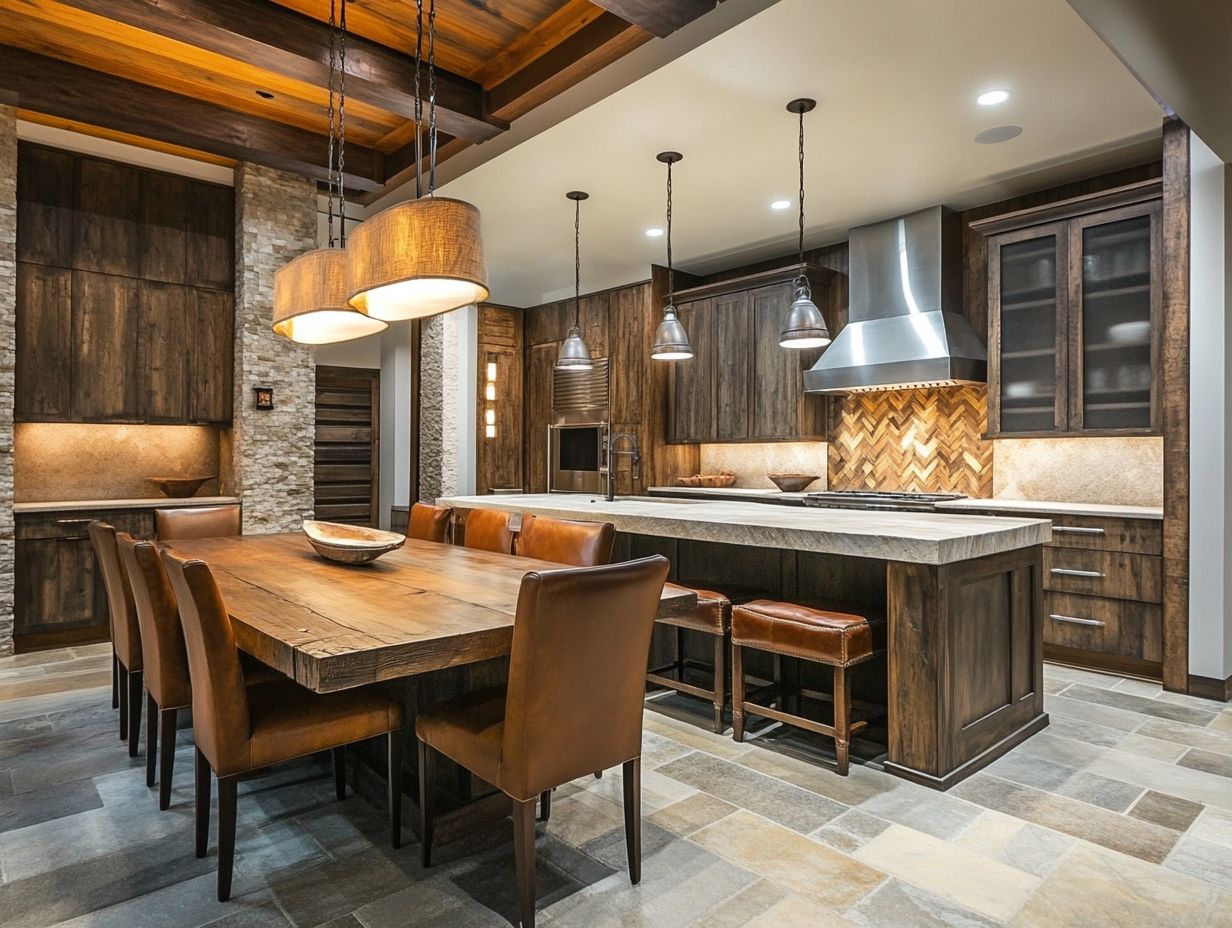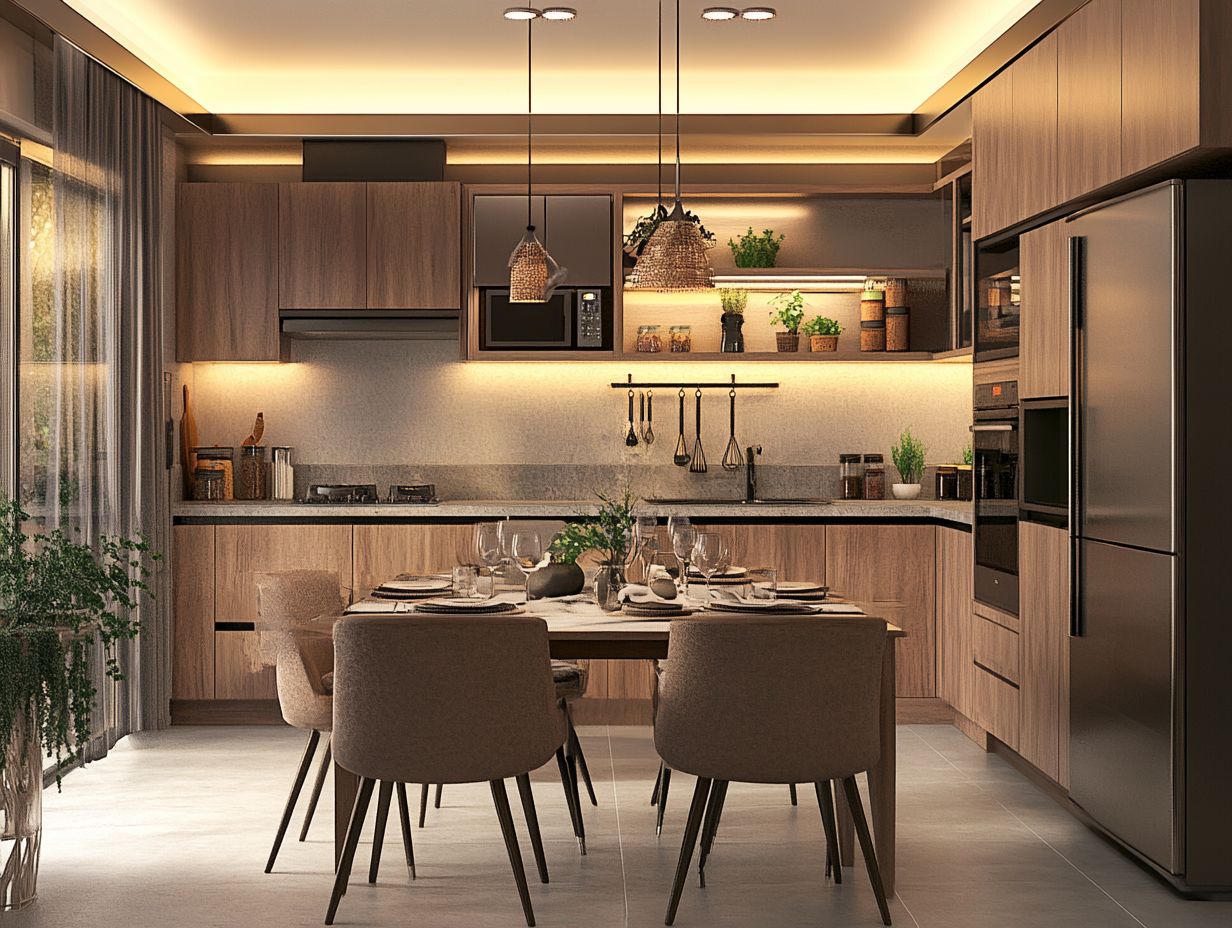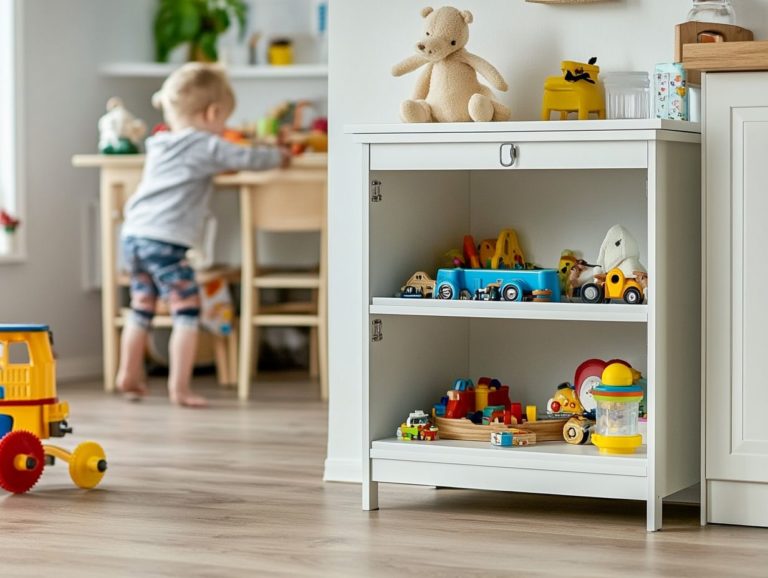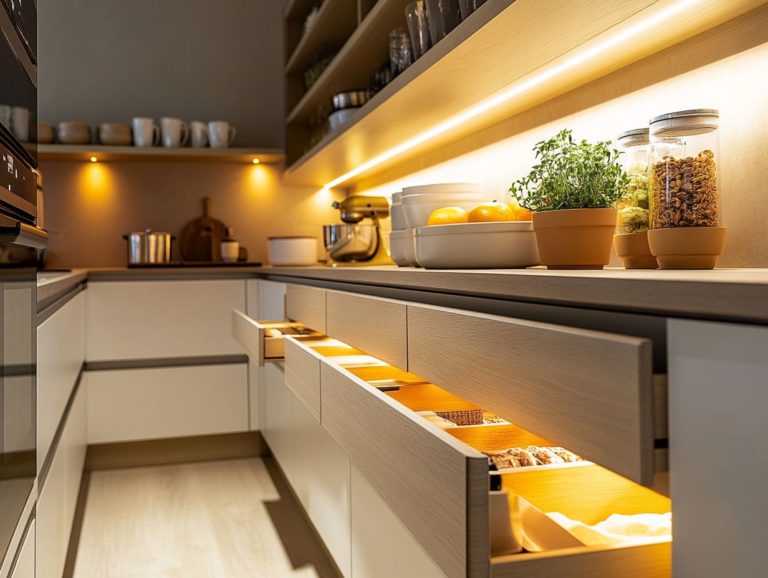The Art of Cabinet Design: Tips for Homeowners
Get ready to transform your spaces! Cabinet design transcends mere practicality; it serves as a canvas for you to infuse your home with both style and functionality.
As you embark on revamping your kitchen, bathroom, or any living area, grasping the key elements and principles of effective cabinet design is essential. This guide delves into crucial factors to consider, from selecting the right materials to maximizing storage space.
Prepare to elevate your spaces with thoughtfully curated cabinet solutions that resonate with your vision!
Contents
- Key Takeaways:
- Understanding Cabinet Design
- Factors to Consider Before Designing Cabinets
- Choosing the Right Materials
- Designing for Different Spaces
- Maximizing Storage and Organization
- Incorporating Personal Style
- Preguntas Frecuentes
- 1. ¿Cuáles son algunos factores importantes a considerar al diseñar armarios para un hogar?
- 2. ¿Cómo puedo aprovechar al máximo el espacio limitado de los armarios?
- 3. ¿Es importante elegir materiales de alta calidad para el diseño de armarios?
- 4. ¿Cómo puedo incorporar elementos de diseño únicos en mis armarios?
- 5. ¿Cuáles son algunos errores comunes que cometen los propietarios al diseñar armarios?
- 6. ¿Se recomienda contratar a un profesional para el diseño de armarios?
Key Takeaways:

- Understand the key elements of cabinet design.
- Ensure cabinets are functional and stylish.
- Choose the right materials for durability and style.
Understanding Cabinet Design
Understanding cabinet design is essential for crafting spaces that are both functional and visually captivating. Whether your taste leans towards sleek modernity or the charm of traditional styles, the design of your kitchen cabinets plays a pivotal role in shaping the overall ambiance of your home.
By integrating intelligent storage solutions and decorative accents, you can elevate your space. Consider the potential of open shelving to enhance your design.
The ideal cabinet design can harmoniously blend with your interior choices, enhancing the visual height of rooms with lofty ceilings and allowing your cherished collections to truly shine.
Key Elements and Principles
Key elements and principles of cabinet design center around functionality and style, ensuring that your kitchen cabinets serve both a practical purpose and a stylish statement. By thoughtfully considering aspects like proportion, scale, and harmony, you can craft cabinetry that complements your kitchen’s layout.
Selecting cabinets that integrate seamlessly with the overall dimensions of your kitchen can ward off feelings of overcrowding while maximizing storage space. Incorporating decorative elements such as crown molding (the decorative trim at the top of cabinets) or distinctive hardware can inject character into your design.
A coordinated color palette and varied textures can contribute to a cohesive appearance, making your kitchen feel inviting while effectively fulfilling its essential functions.
Factors to Consider Before Designing Cabinets
Before you dive into cabinet design, it’s essential to consider several critical factors. Pay particular attention to functionality and style, ensuring they seamlessly complement your living space.
Functionality and Style
Striking the perfect balance between functionality and style is crucial when designing kitchen cabinets, as both elements significantly elevate your overall kitchen experience. As you contemplate a new layout, consider how smart storage solutions can streamline your daily tasks.
Features like pull-out shelves or hidden compartments can maximize your space while keeping your essentials neatly organized. Integrating stylish cabinet fronts or eye-catching hardware can infuse character into your kitchen, transforming it into a visually stunning centerpiece of your home!
Choosing the Right Materials

Selecting the ideal materials for your kitchen cabinets is crucial for achieving durability, style, and functionality. With a range of options available, each presents its distinct advantages and disadvantages.
Tailor your choices to your specific needs and preferences to ensure your cabinets meet your design vision!
Types of Materials and Their Pros and Cons
When selecting materials for your kitchen cabinets, it’s essential to understand the pros and cons of wood, laminate, and metal. Each option has unique characteristics that can influence both the look and functionality of your kitchen.
Wood is known for its timeless beauty, but it often comes with a higher price tag and requires regular maintenance to avoid warping.
Laminate, on the other hand, offers a budget-friendly choice with a wide range of colors and patterns, though it may not be as durable as wood.
Metal cabinets provide a sleek, modern touch and great durability, but they may lack the warmth and variety of other materials.
Weigh these factors carefully. Consider cost, longevity, and maintenance to find the ideal material for your lifestyle and kitchen design.
Designing for Different Spaces
Designing cabinets for different spaces requires careful attention to functionality and style. By considering these elements, you can create areas that are organized and visually appealing.
Kitchen, Bathroom, and Other Rooms
The design of kitchen cabinets differs from bathroom cabinets, requiring tailored approaches for optimal storage. In kitchens, robust solutions are crucial for managing various appliances and utensils while ensuring easy access during meal prep.
Bathroom cabinets focus on space-saving and stylish design, providing just enough room for personal care products without taking up too much space.
Decorative elements are essential in both environments. In kitchens, finishes should harmonize with appliances, while bathrooms benefit from serene colors that promote relaxation.
Maximizing Storage and Organization
Maximizing storage in your kitchen cabinets is crucial for creating a functional space. With deliberate design solutions, you can transform clutter into efficiency.
Tips and Tricks for Efficient Cabinet Design

Implementing tips for efficient cabinet design can greatly elevate your kitchen’s functionality and aesthetics. Incorporate decorative elements like vibrant liners or chic dividers for a visually appealing and organized space.
Use smart storage solutions such as pull-out shelves and tiered organizers to maximize every inch for easy access. Adjustable shelving is also a great idea, allowing you to adapt to various items or seasonal dishware.
With these strategies, your kitchen can blend style and practicality, making cooking and entertaining a delight.
Incorporating Personal Style
Adding your personal style to cabinet design creates a unique kitchen that reflects your tastes. This approach merges functionality with creativity, transforming your kitchen into an inviting environment.
Customization Options and Ideas
Customization options for kitchen cabinets offer a wealth of design ideas that elevate both aesthetics and functionality, enabling you to craft a space that truly reflects your vision.
By choosing colors that complement your overall decor—soft pastels for a tranquil atmosphere or striking bold shades for a statement—you can create a visual impact that’s uniquely yours!
You can also try out different finishes, from matte to high gloss, to add textures that match your taste while ensuring lasting durability.
Choosing the right hardware can make a huge difference! Whether you opt for vintage knobs or sleek modern pulls, it adds an extra touch of character, transforming an ordinary cabinet into a standout feature.
Incorporating decorative elements like crown molding or open shelving not only enhances the visual appeal but also meets practical needs, showcasing your style while improving usability.
Preguntas Frecuentes
1. ¿Cuáles son algunos factores importantes a considerar al diseñar armarios para un hogar?
Al diseñar armarios para un hogar, es importante considerar el estilo y la estética general de la casa, el espacio disponible y la funcionalidad de los armarios. También es esencial pensar en las necesidades y preferencias de almacenamiento específicas del propietario.
2. ¿Cómo puedo aprovechar al máximo el espacio limitado de los armarios?

Para aprovechar al máximo el espacio limitado de los armarios, considera usar soluciones de almacenamiento vertical, como armarios altos o estanterías. Utilizar estantes extraíbles y organizar los artículos según la frecuencia de uso también puede ayudar a maximizar el espacio. Además, considera utilizar el espacio sobre los armarios o agregar ganchos o estantes en el interior de las puertas de los armarios.
3. ¿Es importante elegir materiales de alta calidad para el diseño de armarios?
Sí, es importante elegir materiales de alta calidad para el diseño de armarios, ya que no solo durarán más, sino que también proporcionarán una opción más estéticamente agradable y duradera para tu hogar. Los materiales de calidad también pueden aumentar el valor de tu hogar a largo plazo.
4. ¿Cómo puedo incorporar elementos de diseño únicos en mis armarios?
Incorporar elementos de diseño únicos en tus armarios se puede hacer de varias maneras. Puedes considerar agregar herrajes decorativos, usar diferentes tipos de puertas de armario o incorporar colores o texturas contrastantes. También puedes optar por armarios personalizados que estén específicamente adaptados a tus preferencias de diseño.
5. ¿Cuáles son algunos errores comunes que cometen los propietarios al diseñar armarios?
Algunos errores comunes que cometen los propietarios al diseñar armarios incluyen no considerar el estilo general y la funcionalidad del espacio, no medir adecuadamente el espacio disponible y no planificar suficiente almacenamiento. También es importante considerar el costo y el presupuesto para el proyecto.
6. ¿Se recomienda contratar a un profesional para el diseño de armarios?
Si bien es posible hacer el diseño de armarios tú mismo, se recomienda encarecidamente contratar a un profesional para obtener los mejores resultados. Un diseñador profesional puede ofrecer asesoramiento experto sobre el diseño, los materiales y la funcionalidad, así como asegurar mediciones e instalación adecuadas. También pueden proporcionar soluciones creativas y ayudar a dar vida a tu visión.





